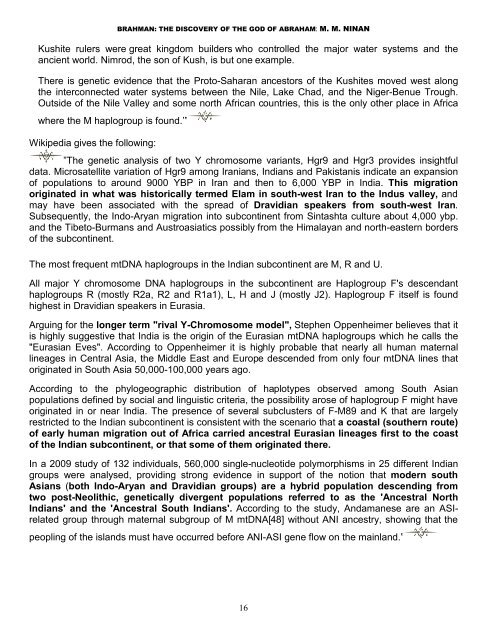You also want an ePaper? Increase the reach of your titles
YUMPU automatically turns print PDFs into web optimized ePapers that Google loves.
BRAHMAN: THE DISCOVERY OF THE GOD OF ABRAHAM: M. M. NINAN<br />
Kushite rulers were great kingdom builders who controlled the major water systems and the<br />
ancient world. Nimrod, the son of Kush, is but one example.<br />
There is genetic evidence that the Proto-Saharan ancestors of the Kushites moved west along<br />
the interconnected water systems between the Nile, Lake Chad, and the Niger-Benue Trough.<br />
Outside of the Nile Valley and some north African countries, this is the only other place in Africa<br />
where the M haplogroup is found.’”<br />
Wikipedia gives the following:<br />
”The genetic analysis of two Y chromosome variants, Hgr9 and Hgr3 provides insightful<br />
data. Microsatellite variation of Hgr9 among Iranians, Indians and Pakistanis indicate an expansion<br />
of populations to around 9000 YBP in Iran and then to 6,000 YBP in India. This migration<br />
originated in what was historically termed Elam in south-west Iran to the Indus valley, and<br />
may have been associated with the spread of Dravidian speakers from south-west Iran.<br />
Subsequently, the Indo-Aryan migration into subcontinent from Sintashta culture about 4,000 ybp.<br />
and the Tibeto-Burmans and Austroasiatics possibly from the Himalayan and north-eastern borders<br />
of the subcontinent.<br />
The most frequent mtDNA haplogroups in the Indian subcontinent are M, R and U.<br />
All major Y chromosome DNA haplogroups in the subcontinent are Haplogroup F's descendant<br />
haplogroups R (mostly R2a, R2 and R1a1), L, H and J (mostly J2). Haplogroup F itself is found<br />
highest in Dravidian speakers in Eurasia.<br />
Arguing for the longer term "rival Y-Chromosome model", Stephen Oppenheimer believes that it<br />
is highly suggestive that India is the origin of the Eurasian mtDNA haplogroups which he calls the<br />
"Eurasian Eves". According to Oppenheimer it is highly probable that nearly all human maternal<br />
lineages in Central Asia, the Middle East and Europe descended from only four mtDNA lines that<br />
originated in South Asia 50,000-100,000 years ago.<br />
According to the phylogeographic distribution of haplotypes observed among South Asian<br />
populations defined by social and linguistic criteria, the possibility arose of haplogroup F might have<br />
originated in or near India. The presence of several subclusters of F-M89 and K that are largely<br />
restricted to the Indian subcontinent is consistent with the scenario that a coastal (southern route)<br />
of early human migration out of Africa carried ancestral Eurasian lineages first to the coast<br />
of the Indian subcontinent, or that some of them originated there.<br />
In a 2009 study of 132 individuals, 560,000 single-nucleotide polymorphisms in 25 different Indian<br />
groups were analysed, providing strong evidence in support of the notion that modern south<br />
Asians (both Indo-Aryan and Dravidian groups) are a hybrid population descending from<br />
two post-Neolithic, genetically divergent populations referred to as the 'Ancestral North<br />
Indians' and the 'Ancestral South Indians'. According to the study, Andamanese are an ASIrelated<br />
group through maternal subgroup of M mtDNA[48] without ANI ancestry, showing that the<br />
peopling of the islands must have occurred before ANI-ASI gene flow on the mainland.”<br />
16


















